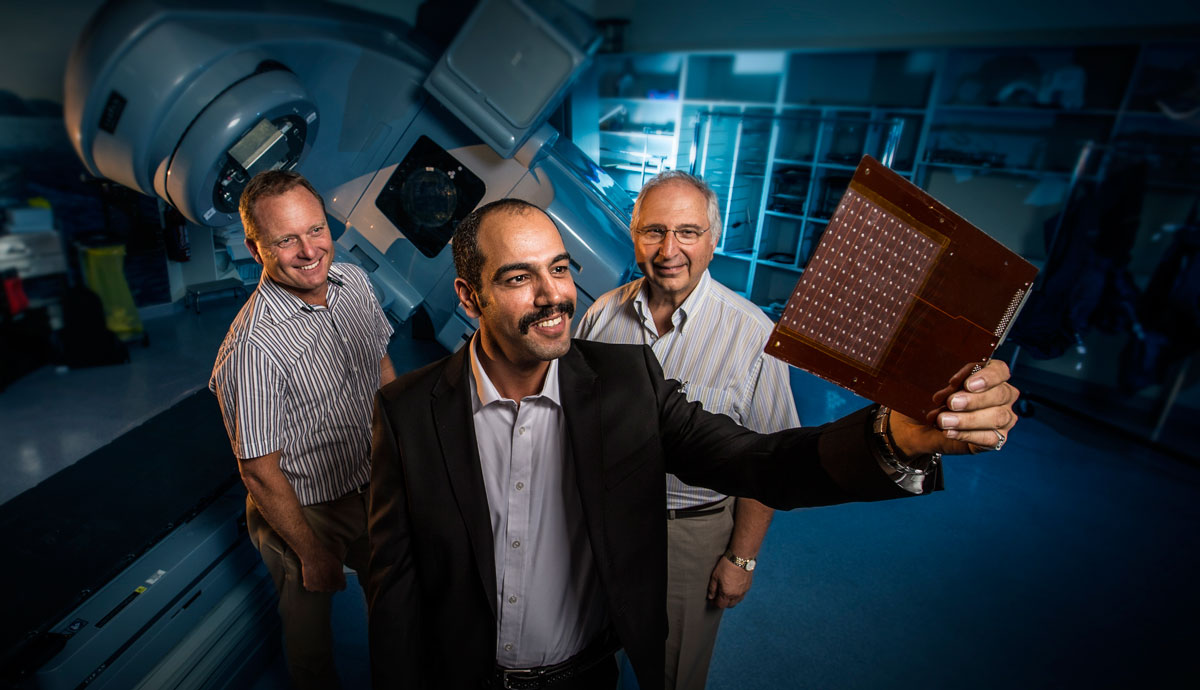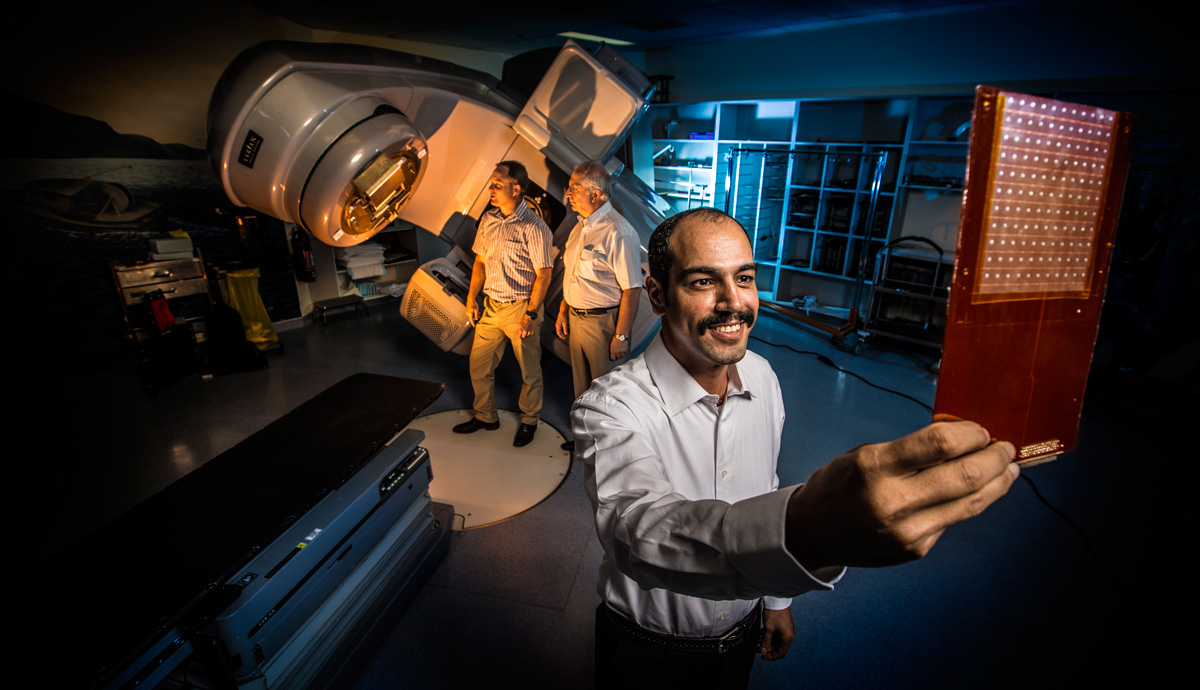March 1, 2016
‘Magic’ radiation detector to improve cancer treatments
A UOW PhD student worked on developing a ‘magic plate’ radiation detector that will help improve the safety of cancer radiotherapy.
For the past three years, Ziyad Alrowaili, from UOW’s Centre for Medical Radiation Physics (CMRP), has been working on a simple and elegant solution for a serious issue: how to precisely measure the amount of radiation a patient receives during cancer treatment.
Modern radiotherapy techniques have become increasingly sophisticated in tailoring the radiation distribution to hit the cancer target. Yet, calculating the dosage of radiation on human tissue is a complex task for medical physicists.
“Nobody in the world has yet managed to develop a simple, cheap and effective way to calculate the radiation dose while the patient is being treated, yet it’s a vital part of patient wellbeing,” Ziyad explained.
Radiation destroys cancer tissue but also harms the patient’s healthy tissue. The side effects of excessive radiation exposure to healthy tissue can include symptoms such as fatigue, skin irritation, hair loss and nausea, depending on the type of treatment used and the part of the body being irradiated.
Yet, an insufficient dose won’t kill the tumour and cancer cells will continue to grow.
“Current procedures typically involve a test on a plastic dummy before the patient is treated, to verify the equipment is delivering the dose according to the oncologist’s treatment plan calculations,” Ziyad said.
“This is an intensive task and an additional workload for the medical physicist. And despite the high levels of quality assurance, the clinician can’t routinely measure the dose accuracy directly during the patient treatment delivery and independently of the linear accelerator settings.
A better measure of treatment success
“My project involved what we have called a ‘magic plate’, which consists of an arrangement of silicon radiation sensors sandwiched between plastic sheets less than 1-millimetre thick that measures the radiation dose during treatment with real-time results.”
The magic plate detector sits in the radiation path and before the x-ray beam hits the patient, records millisecond by millisecond a 2D map of the intensity of the radiation beams.
An algorithm Ziyad has developed determines the dose reaching the patient based on the measured intensity of the x-ray distribution in the beam. This can then be checked against the planned dose and if they disagree, the treatment could be automatically and immediately stopped.
The technical concepts were tested and validated in a simulated environment using different X-ray beam energies that are commonly used to treat cancer patients.
Ziyad, working alongside Dr Martin Carolan, Director of Radiation Oncology Medical Physics at the Illawarra Shoalhaven Local Health District, and academic supervisor Associate Professor Michael Lerch, found the plate did not interfere with the quality of the treatment and accurately recorded in real-time the transmission of the radiation beam.

Dr Carolan said a single patient treatment plan may contain thousands of parameters defining the variables involved, and this complexity makes it imperative that processes are in place to check and verify the x-ray equipment delivers the dose accurately.
“There are many layers of safeguards already in place to reduce the risk to the patient, but the concept of measuring the radiation dose distribution every day as it is delivered to the patient is elegant and appealing,” he said.
“The magic plate detector could be attached to the linear accelerator during patient treatments so that it can continuously record a 2D map of the radiation dose being delivered for comparison with the intended dose plan.
“The result is a method that could be used to ensure patient treatment safety and accuracy on a day to day basis with minimal workload impact for clinicians.”
The next step for the prototype is extensive preclinical evaluation with radiation treatment plans that account for the full range of clinical complexities.
Personal and Global impact
Ziyad’s project has been accelerated through the decades of expertise hot-housed at CMRP, a UOW-based research group led by Distinguished Professor Anatoly Rozenfeld, that is a world leader in the development of quality assurance radiation devices, instrumentation and methods that ensure patients receive the correct dosage.
Professor Rozenfeld authored the underlying patents used in the magic plate development.
“The long standing collaboration between the Medical Physics Unit at the Illawarra Cancer Care Centre, the Centre for Medical Radiation Physics and Physics Department at UOW now spans almost 25 years and Ziyad and his project are an excellent example of the achievements this alliance has produced,” Dr Carolan said.
Ziyad hopes to take the knowledge and expertise he’s gained during his PhD home to Saudi Arabia to start the country’s first medical radiation physics institute at the university where he first studied, Aljouf University.
His research has included three international peer reviewed journal articles and 15 conference presentations.
“The project has been an amazing experience that I hope to be able to give to postgraduate students under my supervision in the future at my home institution,” Ziyad said.
“Personally, the magic plate has a symbolic meaning to me, as it inspires me to develop new ideas that can continue to improve cancer treatment around the world.
“We have all heard tragic stories or know someone who has had cancer. My hope is that this work is a way to support the doctors and oncologists working in hospitals treating cancer patients.
"This type of research would have a real impact in my home country and I’d like to be a part of pioneering such a development.”
